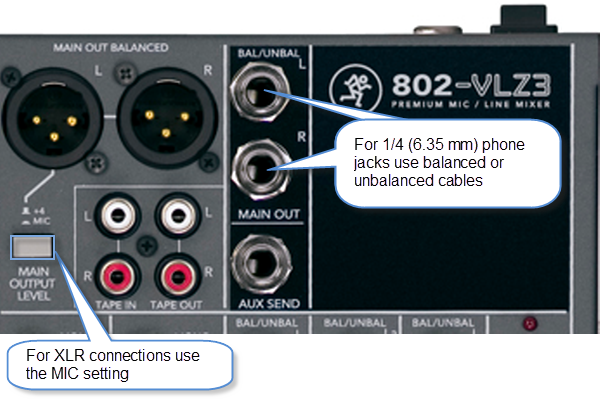Difference between revisions of "Mixer / Mackie / 802-VLZ3"
m (New page: {{Classic icon}}{{Model I icon}} <big>''' Mackie 802-VLZ3 '''</big> == Summary == You can use either the XLR outputs on the rear panel (be sure to set the MIC button "in") :- or - Use th...) |
(No difference)
|
Revision as of 10:22, 2 November 2010
Mackie 802-VLZ3
Contents
Summary
You can use either the XLR outputs on the rear panel (be sure to set the MIC button "in")
- - or -
Use the ¼ inch phone jacks on the top.
Use the XLR - or - ¼ inch phone jack (Tip-Sleeve) outputs to
- The PS1 Power Stand (Classic) / Model I Channels 1 or 2 if you want to use the Presets and the R1 Remote Tone and Level Controls
OR
- The PS1 Power Stand (Classic) / Model I Channels 3 or 4 if you prefer to leave Channels 1 or 2 open for other inputs. You will have to control Tone and relative Level (between the Channels) at your input source, as you do not have this control over Channels 3 and 4 in the PS1 Power Stand (Classic) / Model I or the R1 Remote.
- If you want to use the Balanced XLR outputs use the MIC setting in the picture above.
¼ Inch with suitable output
for PS1 Powerstand Channel 1 or 2 inputs
You can use TS (Tip Sleeve) unbalanced cables, or TRS (Tip Ring Sleeve) balanced cables, but since the ¼ inch phone connections at the Bose Classic and Model I Power Stand are unbalanced there is no particular benefit using balanced cables.
¼ Inch Tip-Sleeve (unbalanced) to ¼ Inch Tip-Sleeve (unbalanced)
This should work fine.
¼ Inch Tip-Ring-Sleeve (balanced) to ¼ Inch Tip-Sleeve (unbalanced)
This should work fine.
¼ Inch Tip-Ring-Sleeve (balanced) to ¼ Inch Tip-Ring-Sleeve (balanced)
This should also work, but likely no better than a simple ¼ Inch Tip-Sleeve to Tip-Sleeve cable. This is because the ¼ Inch input on the Bose System is Tip-Sleeve (unbalanced) anyway.
Links:



